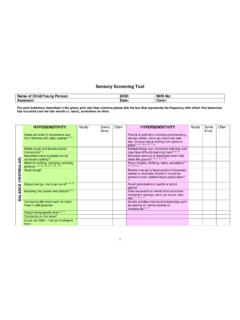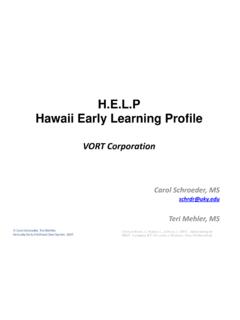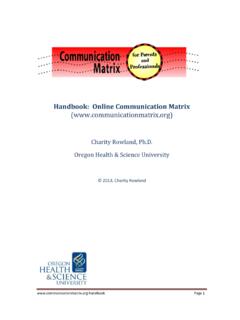Transcription of Nursing Sensitive Outcome Indicators - WFCCN
1 Nursing Sensitive Outcome IndicatorsEsther Y H Wong, L S Chau, K Y Yu, Rowlina P W Leung, Peter C K Lai, Joanna W P Lo, S F LeeCHAPTER TWELVE}120 LEARNING OUTCOMESA fter completing this chapter you will be able to: Identify the characteristics of Nursing Sensitive Outcome Indicators Review the definitions of fall, displacement of tubes/lines/drains and medication incidents Understand the risk factors of falls in intensive care Highlight strategies of fall prevention Discuss recommendations for minimizing the chance of displacement of tube/line/drains Explain the types and causes of medication errors in intensive care unit Discuss strategies for improving medication safety Identify evidence-based interventions that are effective in enhancing patient and family satisfaction Discuss the role of the nurse in promoting improved care in the ICU using Nursing Sensitive Outcome Indicators INTRODUCTIONThe dawn of the twenty-first century marks a new era for the entire Nursing profession.
2 To keep pace with the ageing population; advanced technology; rising public expectation; escalating healthcare costs; and the advent of modern medicine; coupled with the need to achieve improvement in healthcare quality and safety, clinical nurses, and nurse executives are increasingly concerned about measuring the outcomes of care in their workplace and gathering evidence to justify their decisions for resources allocation. The growing sophistication of the health care systems everywhere calls for an increased emphasis on evidence and outcomes. Gallagher and Rowell (2003) opined that:The provision of Outcome -oriented, cost-effective health care is no longer a goal. It is a mandate.
3 To accomplish this mandate, the relationship between the costs, quality and desired outcomes of care, and the processes involved in providing care must be reexamined. Successful Indicators that capture Nursing - Sensitive patient outcomes tie together research findings and best practices in an effort to create better patient care. What are Nursing Sensitive Outcome /quality Indicators ? The American Nurses Association (ANA, 1996) defined Nursing - Sensitive quality Indicators as those Indicators that capture care or are most affected by Nursing care. The use of nurse Sensitive quality Indicators in Intensive Care Units (ICU) has been as a tool to show the clear linkages between Nursing interventions, staffing levels, and positive patient outcomes.
4 Nursing Sensitive quality Indicators (NSQIs) and Nursing Sensitive outcomes Indicators (NSOIs) are referring to the same thing - patient outcomes that are directly or indirectly influenced by Nursing (Dorman, 1977). In 1998, the ANA funded the development of a national database named as the National Database of Nursing Quality Indicators (NDNQI). Its goals are to promote and facilitate the standardization of information submitted by hospitals across the United States on Nursing quality and patient outcomes. Yang et al. (1999) defined NSOI as: changes in health status upon which Nursing care has had a direct influence. The International Council of Nurses (ICN, 2001) stated it is .. the measure or status of a Nursing diagnosis at points in time after a Nursing intervention.
5 Nursing - Sensitive Indicators are specific to Nursing and differ from medical Indicators of care quality. As such, Nursing outcomes Indicators are those outcomes most influenced by Nursing care (Montalvo, 2007). NDNQI began formally collecting data related to ten NSQIs for acute care settings including: Total Nursing care hours provided per patient day Mix of RNs, LPNs and unlicensed staff caring for patients in acute care settings Pressure ulcers (terminology in 2015) Nursing staff satisfaction Nosocomial infection rate (bacteremia s associated with central lines) Patient falls Patient satisfaction with overall care Patient satisfaction with educational information Patient satisfaction with pain management Patient satisfaction with Nursing care.
6 ( Nursing Administration Quarterly 2003; Nursing World, ANA indicator History, 2015) The recommended definitions of the ten Indicators can be found in ANA s 2015 publication. In this chapter fall displacement of tubes/lines/drains, medication incidents and patient/family satisfaction and related Indicators will be discussed as it relates to critical care Nursing . The Joint Commission started incorporating NSOIs into its standards for accreditation. Nowadays, Nursing - Sensitive Indicators are widely used. As an example of how NSOI can be used to monitor Nursing impact, data collection for NSOIs in ICUs started in 2005 in Hong Kong. Currently fifteen ICUs in public hospitals (at Level II and above) in Hong Kong contribute to this database.
7 Hong Kong established a set of Specialty Guidelines for ICU nurses in which service Indicators were listed as follows: Patient-focused Outcome Indicators listed in the Specialty (ICU) Guidelines: Treatment/care modality Indicators : Adverse Incident rates such as medication incident rate, patient fall rate and displacement of tubes; complications such as pressure injury rate and nosocomial infection rate; number of resuscitation episodes versus successful resuscitation } Nursing Sensitive Outcome IndicatorsPsychosocial Indicators Knowledge level; satisfaction level; number of complaints; number of compliments. General Indicators Mortality rate; length of stay; unplanned readmission of the above-mentioned psychosocial Indicators and general Indicators has been conducted at the hospital level.
8 Data collection has focused on seven NSOIs which are grouped under three categories: Adverse incidents Patient falls Displacement of tubes, lines and drains Medication errorsComplications Pressure injury Nosocomial infection (see Chapter 10)Patient and family satisfaction Patient and family's satisfaction on the quality of care received. We revisited the term Nursing Sensitive outcomes Indicators ; studied the topic in depth; confirmed and defined the Indicators to be reported; devised NSOI formulas for calculating rates; devised reporting forms to capture data; designed a Training Need Analysis Tool and refined questionnaire for satisfaction survey (patient and family). Since early 2005, data on four NSOIs (patient falls, displacement of tubes, lines and drains, medication errors and pressure injury) were captured in ICUs (at departmental/unit level) and reported on a six-monthly basis.
9 We aimed at capturing quality data for performance improvement and for presenting as a profile of ICU quality in the form of NSOIs because data collected can be used to compare among ICUs and to trend over time. Hospital-acquired infection (nosocomial infection) data were collected by the infection control unit and a satisfaction survey (patient/patient s family) was conducted at the hospital level. Hence, an inventory of patient outcomes related to the scope of ICU Nursing practice confirmed and data were collected at departmental level of all the public hospitals. Examples from this initiative are provided throughout this chapter to highlight the role of the critical care nurse in improving patient care in the ICU.
10 ACUTE CARE PATIENT FALL NSOI definitions and measurements Adverse incident: acute care patient fall The World Health Organization (2018) describes Fall an event which results in a person coming to rest inadvertently on the ground or floor or other lower level. Jeffs et al. (2005) defined acute care patient fall as the rate per 1000 patient days at which patients experience an unplanned descent to the floor during the course of ICU stay. All falls (accidental fall, unanticipated physiologic fall, and anticipated physiologic fall) should be reported and described by level of injury or no injury. Falls resulting from violent blows or other purposeful actions should be excluded (US Department of Veterans Affairs, 2014).




